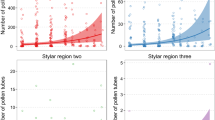Abstract
Pollinator behavior influences plant reproduction in many ways. A traditional measure of pollination, the number of visits received, may be a poor predictor of plant reproductive success, particularly when there are trade-offs between visit quantity and components of visit quality. For example, the duration of pollinator visits may be negatively correlated with the number of visits received by a flower. We tested for a trade-off between the number of bumblebee visits and the duration of those visits in an experimental population of snapdragons (Antirrhinummajus: Scrophulariaceae). The duration of a bumblebee visit to a flower increased significantly with the time interval since the flower had last been visited. Over the lifetime of a flower the correlation between the total number and average duration of visits received by a flower was weakly negative. However, at the whole-plant level the correlation was positive: plants whose flowers received more visits also received visits of longer duration. Factors affecting the relationship between quantity and duration of pollinator visits to flowers also were investigated. Two factors weakened the negative dependence of average visit duration on number of visits received by individual snapdragon flowers: (1) the correlation between the total number of visits to a flower and the average interval between visits was only −0.53, as visits to individual flowers were not very evenly spaced over time, and (2) newly opened flowers received fewer and shorter visits than older flowers. Comparing whole plants, nectar production per flower varied dramatically across individuals, a probable explanation for the positive correlation between visit number and average duration per flower observed at the plant level. The potential for a trade-off between these two components of pollinator service exists when visit duration depends on reward quantity; whether the trade-off is realized will depend on variation in nectar production and on whether pollinators forage systematically.
Similar content being viewed by others
Author information
Authors and Affiliations
Additional information
Received: 3 October 1997 / Accepted: 16 June 1998
Rights and permissions
About this article
Cite this article
Jones, K., Reithel, J. & Irwin, R. A trade-off between the frequency and duration of bumblebee visits to flowers. Oecologia 117, 161–168 (1998). https://doi.org/10.1007/s004420050644
Issue Date:
DOI: https://doi.org/10.1007/s004420050644




